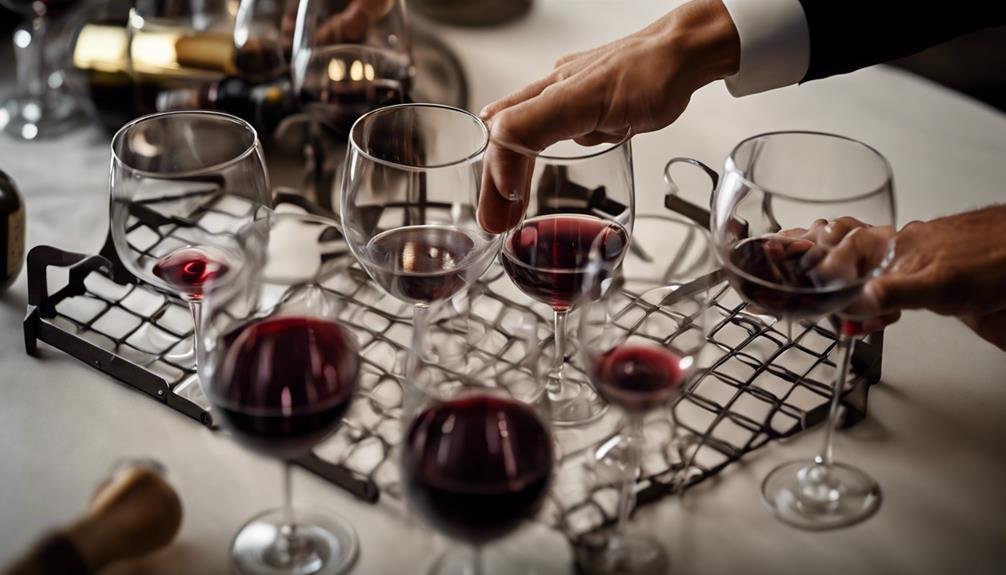Reveal the wine tasting grid's mystery by understanding its components like color, brightness, acidity, and tannins. Mastering aroma identification and taste perception is vital for exploring wine complexities. Use tools like appropriate glassware and tasting grids for accurate evaluation. Decode wine complexity by analyzing taste evolution and tannin levels, essential for quality assessment. Balance in wines guarantees a pleasurable tasting experience. Start unraveling the enigmatic intricacies of the wine tasting grid to enhance your wine evaluation skills and appreciation.
Understanding the Grid Components
In dissecting the intricacies of the wine tasting grid, a structured breakdown of its components serves as the fundamental groundwork for trained tasters to discern and classify wine characteristics effectively.
Visual assessment plays an important role in identifying a wine's color, clarity, brightness, and intensity. This initial step sets the stage for further analysis.
Structure analysis, another key component, explores the wine's body, acidity, tannins, and alcohol levels. Understanding these elements aids in determining the overall quality and style of the wine being tasted.
By integrating visual assessment and structure analysis, tasters can form a thorough understanding of the wine's profile, enabling them to make informed judgments and classifications.
Mastering these foundational components is essential for developing expertise in wine evaluation and appreciation.
Mastering Aroma and Flavor Assessment
Understanding the nuances of aroma and flavor assessment is an essential aspect of mastering the art of wine evaluation within the tasting grid system. Aroma identification plays a critical role in sensory exploration, where tasters discern various scents like fruity, floral, or oaky notes.
When it comes to flavor pairing, taste perception is key; recognizing flavors like citrus, berries, or spices enhances the overall tasting experience. By honing these skills, tasters can explore further into the complexities of different wines, pinpointing unique characteristics that define each bottle.
Mastering aroma and flavor assessment allows for a more insightful evaluation, leading to a richer understanding and appreciation of the diverse world of wines.
Essential Tools for Wine Tasting

Mastering the art of wine evaluation within the tasting grid system requires utilizing essential tools for precise sensory exploration and identification.
- Tasting Techniques and Sensory Skills: Developing these skills allows for a thorough analysis of wine characteristics and quality.
- Glassware Selection and Pouring Etiquette: Choosing the right wine glass impacts aroma concentration and overall tasting experience.
- White Paper and Tasting Grid: Important for jotting down observations and organizing wine evaluation systematically.
- Clear Head and Pen: These tools guarantee focused attention and the ability to record findings accurately during the tasting process.
Decoding Wine Complexity and Length
Unraveling the intricacies of wine complexity and length is essential for evaluating and appreciating the quality of a wine.
Wines with high complexity offer a myriad of flavors that evolve throughout the tasting, providing a richer and more fulfilling experience. This complexity often signifies superior quality, with the interplay of alcohol, acidity, and tannins enhancing the length of flavors.
Analyzing taste evolution from the first sip to the lingering finish allows for a deeper understanding and appreciation of the wine's nuances. Longer flavor length is generally associated with higher quality wines, indicating a well-balanced and harmonious composition.
Exploring Tannin Levels and Balance

Exploring the nuanced interplay between tannin levels and balance in wine reveals essential aspects of its quality and sensory experience.
- Tannin Analysis:
- Tannins are compounds found in grape skins, seeds, and stems that contribute to a wine's structure and mouthfeel.
- Different grape varieties and winemaking techniques result in varying tannin levels, impacting the wine's overall texture.
- Balance Evaluation:
- Balance in wine refers to the harmonious relationship between its components like acidity, sweetness, alcohol, and tannins.
- Well-balanced wines showcase a seamless integration of these elements, providing a pleasurable tasting experience.
Understanding the interplay between tannin levels and balance is essential for evaluating wine quality and enjoying a well-rounded sensory journey.
Frequently Asked Questions
How Can I Improve My Ability to Detect Subtle Wine Aromas?
To enhance the detection of subtle wine aromas, engage in scent training and concentration techniques. Practice aroma identification through sensory exercises, focusing on discerning nuanced scents. Consistent training and heightened sensory awareness can refine your ability.
What Role Does Temperature Play in Wine Tasting Accuracy?
Temperature control in wine tasting is essential for accurate sensory analysis. The impact of temperature on wine greatly influences flavor recognition. Ensuring proper temperature management enhances the tasting experience by revealing intricate nuances and maximizing enjoyment for discerning palates.
Are There Specific Techniques to Enhance Wine Flavor Perception?
Using sensory training techniques can enhance wine flavor perception. Understanding flavor pairing and developing a discerning palate through practice can improve the ability to identify and appreciate complex flavors in wines, elevating the overall tasting experience.
Can the Shape of the Wine Glass Affect Tasting Outcomes?
Glass shape greatly impacts wine perception. Varying shapes alter aroma concentration, taste sensation, and overall experience. Tasting environment also plays a pivotal role in shaping perceptions, as factors like lighting, temperature, and background noise can influence tasting outcomes.
How Do Different Types of Soils Impact Wine Characteristics?
Different types of soils, such as limestone, clay, or gravel, influence wine characteristics by imparting distinct mineral qualities. These soil variations impact grapevine root development, affecting nutrient uptake and ultimately contributing to diverse flavor profiles in wines.
Conclusion
In unraveling the intricacies of the wine tasting grid, we are reminded that the true essence of wine lies not in the complexity of its flavors, but in the art of deciphering its nuances with precision and expertise.
As we navigate through the structured components of the grid, we are guided to a world where sensory perception and analytical skills converge to illuminate the enigmatic world of wine evaluation.
Cheers to the journey of decoding wine's mysteries!